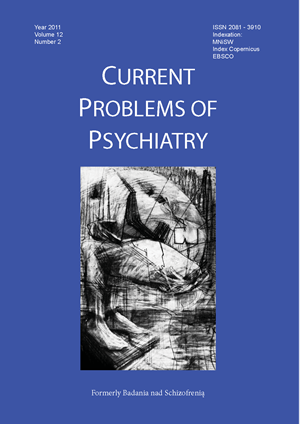Bezpieczeństwo odkażania pochwy 3% alkoholowym roztworem jodu: ocena funkcji tarczycy u kobiet bez czynników ryzyka chorób tarczycy
Słowa kluczowe:
roztwór jodu, okres okołoporodowy, hormony tarczycyAbstrakt
Celem badania była ocean funkcji tarczycy u zdrowych kobiet bez czynników ryzyka chorób gruczołu tarczowego, którym po cięciu cesarskim wykonano dezynfekcję pochwy 3% alkoholowym roztworem jodu. Grupę badaną stanowiło 31 kobiet. Badanie ukończyło 28 z nich. Stężenie hormonów tarczycy i TSH w surowicy krwi oceniano bezpośrednio przed cięciem cesarskim oraz po miesiącu i 3 miesiącach od niego.
Wyniki: U 14% badanych kobiet doszło do spadku stężenia TSH w trakcie badania. U 1 kobiety rozwinęły się objawy niedoczynności tarczycy.
Wnioski: Kobiety, u których zastosowano roztwór jodu w okresie okołoporodowym powinny być obserwowane pod kątem potencjalnych zaburzeń funkcji tarczycy.
Bibliografia
1. Szybiński Z., Delange F., Lewinski A., Podoba J., Rybakowa M., Wasik R., et al. A programme of iodine supplementation using only iodised household salt is efficient - the case of Poland. Eur. J. Endocrinol., 2001; 144(4): 331-337.
2. Lewinski A., Szybinski Z., Bandurska-Stankiewicz E., Grzywa M., Karwowska A. Kinalska I. et al. Iodine-induced hyperthyroidism - an epidemiological survey several years after institution of iodine prophylaxis in Poland. J. Endocrinol. Invest., 2003; 26(Suppl.2): 57-62.
3. Aghini-Lombardi F., Antonangeli L., Martino E., Vitti P., Maccherini D., Leoli F. et al. The Spectrum of Thyroid Disorders in an Iodine-Deficient Community: The Pescopagano Survey. J. Clin. Endocrinol. Metab., 1999; 84(2): 561-566.
4. Dohan O., De la Vieja A., Carrasco N. Molecular Study of sodiumiodide symporter (NIS): a new filed in thyroidology. Trends Endocrinol. Metab., 2000; 11(3): 99-105.
5. Delange F. Iodine deficiency in Europe and its consequences: an update. Eur. J. Nucl. Med. Mol. Imaging., 2002; (Suppl.2): 404-416.
6. Demers L.M., Spencer C.A. Laboratory medicine practise guidelines: laboratory support for the diagnosis and monitoring of thyroid disease. Clin. Endocrinol. (Oxf)., 2003; 58(2): 138-140.
7. Baloch Z., Carayon P., Conte-Devolx B., Demers L.M., Feldt-Rasmussen H., Henry I.F., et al. Guidelines Committee, National Academy of Clinical Biochemistry: Laboratory medicine practice guidelines. Laboratory support for the diagnosis and monitoring of thyroid disease. Thyroid, 2003; 13(1), 3-126.
8 Bostanci I., Sarogliu A., Ergin H., Aksit A., Cinbis M., Akalin N. Neonatal goiter caused by expectorans usage. J. Pediatr. Endocrinol. Metab., 2001; 14(8): 1162-1162.
9. Semba R., Delange F. Iodine in human milk: Perspectives for infant health. Nutr. Rev., 2001; 59(8): 269-278.
10. Paravacini E., Fontana C., Paterlini G., Taglianbe P., Rovelli F., Leung K., et al. Iodine, thyroid function, very low birth weight infants. Pediatrics, 1996; 98: 730-34.
11. Harada S., Ichihara N., Arai J., Honma H., Matsuura N., Fujieda K. Influence of iodine excess due to iodine-containing antiseptics on neonatal screening for congenital hypothyroidism in Hokkaido prefecture. Screening 3, 1994; 3: 115-123.
12. Howard R. Appriopriate use of topical antimicrobials and antiseptics in children. Pediatr. Ann., 2001; 30(4): 219-225.
13. Bostanci I., Sarogliu A., Ergin H., Aksit A., Cinbis M., Akalin N.: Neonatal goiter caused by expectorans usage. J. Pediatr. Endocrinol. Metab., 2001; 14(8): 1162-1162.
14. Richards K., Stasko T. Dermatologic surgery and the pregnant patient. Dermatol. Surg., 2002; 28(3): 248-256.
15. Heymann W.R. Potassium iodide and the Wolf-Chaikoff effect: relevance for dermatologist. J. Am. Acad. Dermatol., 2000; 42: 490-492.
16. Reid V.C., Hartman K.E., Mc Mahon M., Fry E.P. Vaginal preparation with povidone-iodine prior to cesarean section did not reduce pospartum infection. Obstet. Gynecol., 2001; 3: 186-187.
17. Glinoer D. The regulation of thyroid function during normal pregnancy:importance of the iodine nutrition status. J. Clin. Endocrinol. Metab., 2004; 18(2) 133-152.
18. Bournaud C., Orgiazzi J. Iodine excess and thyroid autoimmunity. J. Endocrinol. Invest., 2003; 26(Suppl.2): 49-56.
19 Sakaihara M., Yamada H., Kato E., Ebina Y., Shimada S., Kobashi G., et al. Postpartum thyroid dysfuntion in women with normal thyroid funtion during pregnancy. Clin. Endocrinol., 2000; 53(4): 487-492.
20. Roti E., Uberti E. Post-partum thyroiditis – a clinical update. Eur. J. Endocrinol., 2002; 146(3): 275-279.
21. Laurberg P., Bullow Pedersen I., Knudsen N., Oversen L., Andersen S. Enviromental iodine intake affect the type of nonmalignant thyroid disease. Thyroid, 2001; 11(5): 457-469.
22. Diez J.J. Hyperthyroidism in patients older than 55 years: an analysis of the etiology and management. Gerontology, 2003; 49(5): 316-23.
23. Yang F., Teng W., Shan Z., Guan H., Li Y., Jin Y., et al. Epidemiological survey on the relationship between different iodine intakes and prevalence of hyperthyroidism. Eur. J. Endocrinol., 2002; 146(5): 613-618.
24. Lazarus J., Kokandi A. Thyroid disease in relation to pregnancy: A decade of change. Clin. Endocrinol., 2000; 53(3): 265-278.
25. Yilmaz D., Tezic H.T., Zorlu P., Firat S., Bilaloglu E., Kotlu A. Single dose povidone-iodine on thyroid functions and urinary iodineexcretion. Indian Journal of Pediatrics, 2003; 70(8): 675-677.
26. Garland J.S., Alex C.P., Otten D., Shivpuri C., Harris M.C., Naples M., et al. A randomised trial comparing povidone-iodine to chlorhexidine gluconate-impregnated dressing for prevention of central venous catheter infections in neonates. Pediatrics. 2001; 107(6): 1431-1438.
27. Morgan J., Haugl R., Kosman J. Antimicrobal Skin Preparation for the Maxillofacial Region. J. Oral Maxillofac. Surg., 1996; 54(1): 89-94.
Pobrania
Opublikowane
Numer
Dział
Licencja
Prawa autorskie (c) 2011 Autorzy

Praca jest udostępniana na licencji Creative Commons Attribution-NonCommercial-NoDerivatives 3.0 Unported License.


